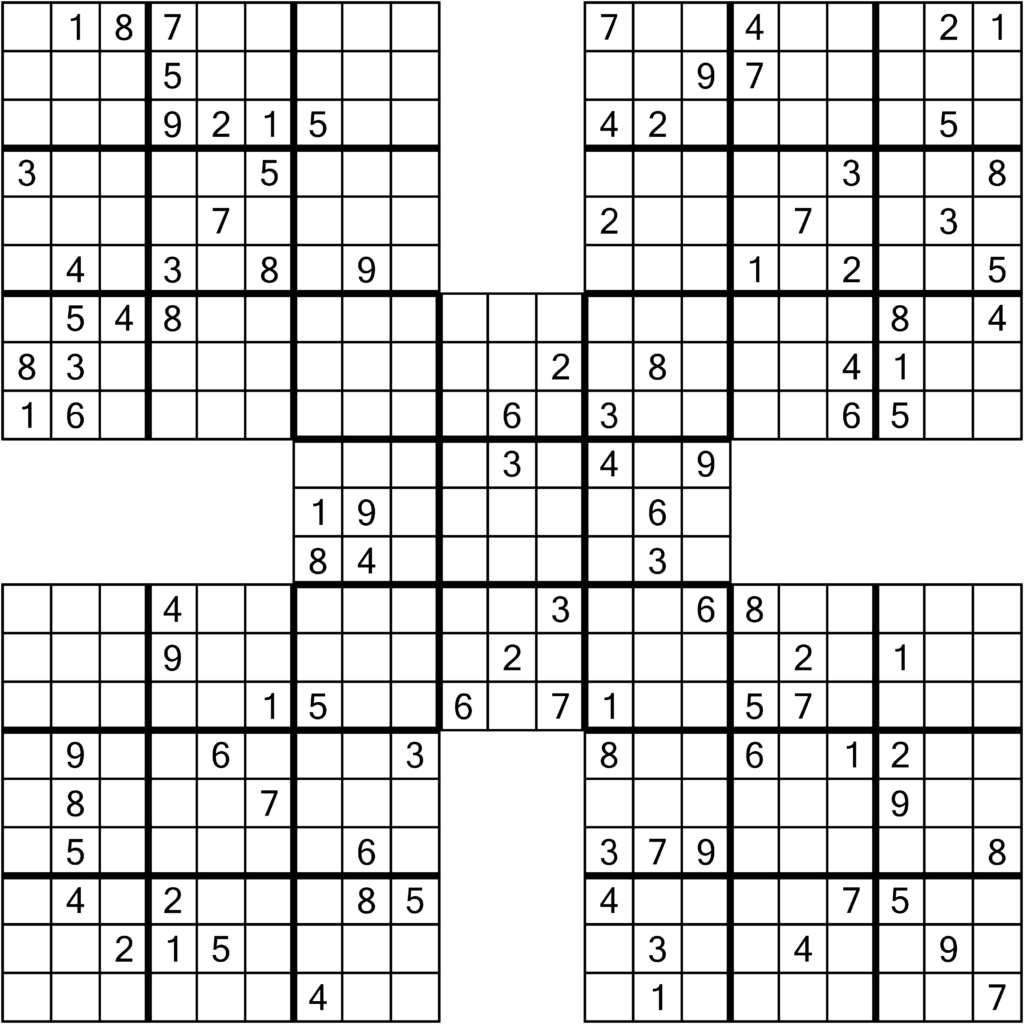Samurai Sudoku
Welcome to the captivating world of Samurai Sudoku, a grand and expansive variation of traditional Sudoku that promises to elevate your puzzle-solving experience to new heights. Samurai Sudoku is perfect for those who find regular Sudoku puzzles a bit too straightforward and are seeking a more substantial challenge.

In this Sudoku variations, the puzzle grid consists of five Sudoku grids interlocked together, typically with one central grid and four additional grids placed at each corner of the central one. This design forms a cross-like structure that not only looks impressive but also adds layers of complexity and intrigue to the familiar Sudoku format.
Each of the five grids follows the standard Sudoku rules – every row, column, and 3×3 box must contain all the digits from 1 to 9, with no repetition. The challenge, and the unique twist of Samurai Sudoku, lies in how these grids interact. The overlapping areas – where the corner grids meet the central grid – are shared, meaning the numbers you place in these sections must satisfy the requirements of both intersecting grids.
This interplay between the grids creates a fascinating puzzle-solving journey, demanding not just a mastery of traditional Sudoku tactics but also an enhanced level of strategic thinking and foresight. Samurai Sudoku is a test of endurance, concentration, and skill, making it an immensely rewarding endeavor for any puzzle enthusiast.
Whether you’re a seasoned Sudoku solver looking for a marathon challenge or a curious newcomer drawn to its complex allure, Samurai Sudoku offers hours of stimulating brain exercise. So, prepare yourself for an epic adventure in number logic with Samurai Sudoku – where the journey is as rewarding as the destination!
How to Play Samurai Sudoku
The Grid
The puzzle playing grid consists of five interlocking 9×9 Sudoku grids arranged in a cross pattern. The central grid is the connecting point for the four surrounding grids.
Basic Rules
The basic rules of Sudoku apply: Within each of the 5 grids, each row, column, and 3×3 box must contain all digits from 1 to 9, with no repetition. The challenge occurs with the areas that overlap in the interlocking grids. These areas are part of both grids and the rules still apply to all grids.
Solving Strategies
- Start with One Grid: Begin by solving one of the 9×9 grids as you would a standard Sudoku puzzle, especially focusing on the central grid or any grid with several given numbers.
- Move to Overlapping Areas: Once you have some numbers in place, start working on the overlapping areas. The numbers you place here will affect two grids, so move cautiously.
- Tackle Grids One by One: After making progress in the overlapping areas, shift your focus to another grid, using any numbers you’ve placed in the overlapping areas as guides.
- Continue the Pattern: Keep applying standard Sudoku strategies (like looking for singles, pairs, and using process of elimination) across the grids, moving through the overlapping areas, and into adjacent grids.
- Balancing Between Grids: Regularly switch between the grids to balance the progress across the entire puzzle. Numbers in one grid often unlock possibilities in another.
- Maintain Patience and Attention to Detail: Given its size, Samurai Sudoku requires more time and concentration. Take breaks if needed, and keep track of your progress methodically.
Traditional Sudoku Strategies in Samurai Sudoku
Applying Standard Sudoku Techniques
The core strategies of traditional Sudoku are not only applicable but also essential in solving Samurai Sudoku puzzles. Here’s how these familiar tactics come into play:
- Single Possibility and Scanning: As in standard Sudoku, you often start by identifying cells where only one number can fit based on the existing numbers in the row, column, and 3×3 box. This basic strategy applies to each individual grid in Samurai Sudoku.
- Naked and Hidden Pairs/Triples: This involves identifying pairs or triples of numbers that can only go in two or three cells within a row, column, or box. These strategies help in reducing possibilities and are effective in both the individual and overlapping regions of Samurai Sudoku.
- Elimination and Deduction: Using the process of elimination is key in Sudoku. In Samurai Sudoku, this not only applies within each 9×9 grid but also in the context of how the overlapping areas influence each grid.
Challenges Unique to Samurai Sudoku:
While traditional strategies are crucial, their application in Samurai Sudoku comes with unique challenges:
- Interconnected Grids: The overlapping areas in the puzzle grid mean that each grid is not solved in isolation. A number placed in an overlapping area affects two grids, so choices need to be made more cautiously.
- Increased Scale and Complexity: The sheer size of the playing grid, with five interconnected grids, can make it challenging to keep track of all the possibilities and constraints. This can make the straightforward application of some strategies more taxing and time-consuming.
- Balancing Focus: In traditional Sudoku, you focus on one 9×9 grid. In Samurai Sudoku, balancing your attention among five grids is a skill in itself. It’s easy to get absorbed in one grid and overlook opportunities or constraints in another.
- Breaks for Reflection: Given its complexity, stepping back for breaks and returning with a fresh perspective can be more beneficial in Samurai Sudoku compared to standard Sudoku.
Mastering Samurai Sudoku, with its unique interconnected grid format, requires not just traditional Sudoku strategies but also a holistic, patient approach and keen attention to detail. Adapting these strategies to its complex and extensive puzzles is crucial. More than just solving a puzzle, Samurai Sudoku offers a rich, rewarding journey through a tapestry of interlinked challenges, where each step forward brings its own sense of achievement.